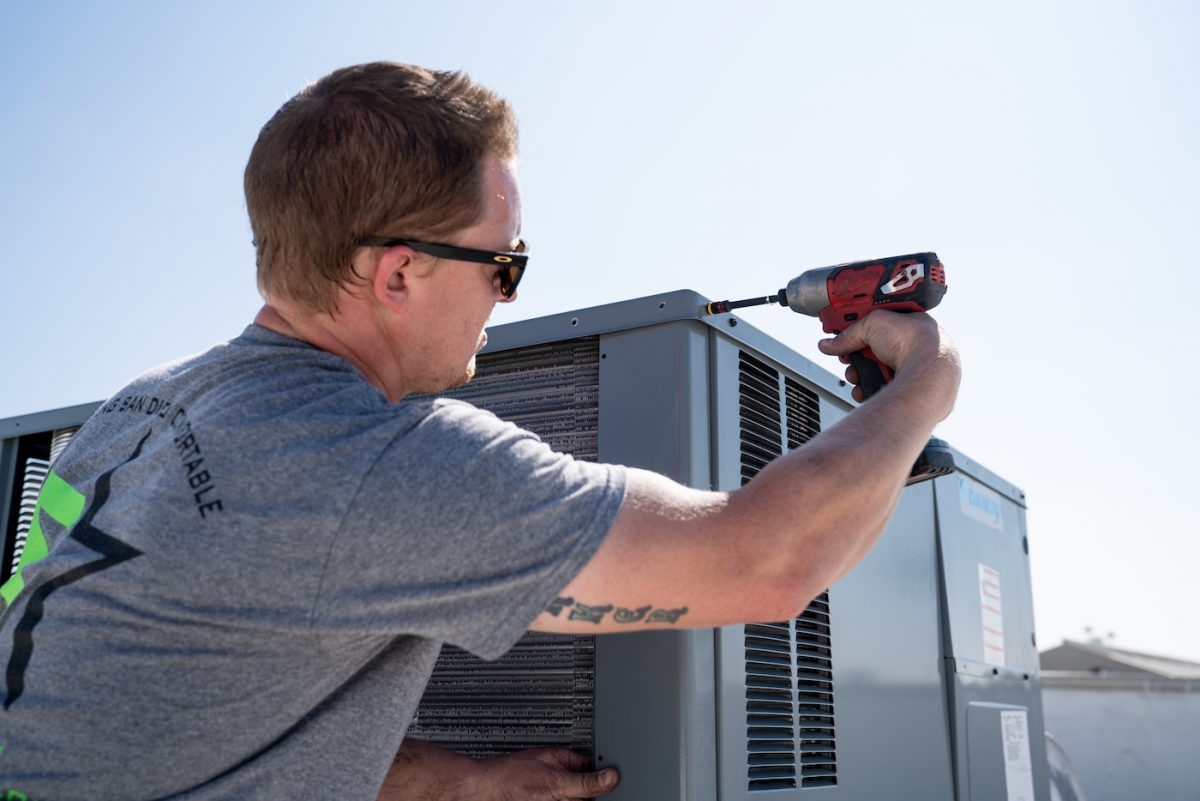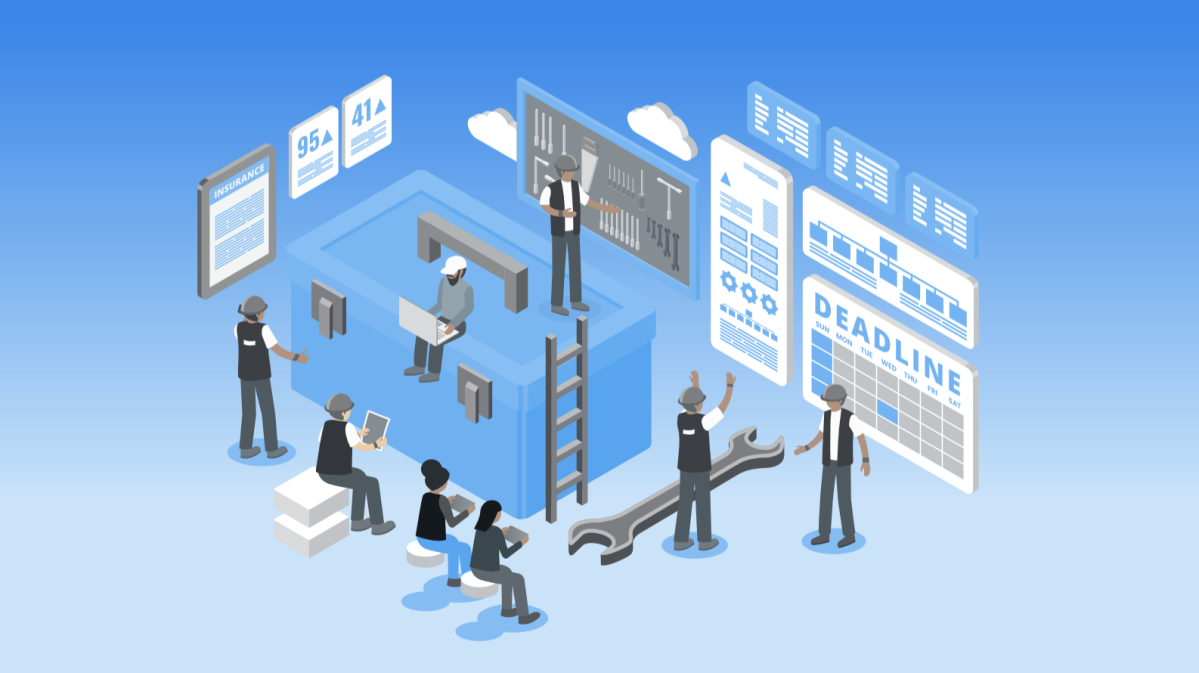Want to win more jobs with less effort?
Grow your business and send quick quotes with our home service software.

Lawn care businesses face a common challenge—and it’s not just overgrown grass. It’s about getting paid after the job is done. A report by the Small Business Credit Survey reveals that nearly 40% of small business owners lament about customers dragging their feet at the time of payment, whereas 20% of owners agree that billing and invoicing take up a significant portion of their time and energy.
Add to that confusing payment terms, missing checks, and outdated payment methods—all of which drain time and revenue. Growing your business becomes twice as hard when the cash flow becomes unpredictable. As a result, “how to collect lawn care payment” is a question many lawn care professionals are left wondering.
The good news is that you can avoid most of these headaches with a well-organized lawn care payment system that keeps both you and your customers happy. In this article, we’ll show you exactly how to do that. By the end of this post, you’ll learn how to offer flexible lawn care payment options, send invoices faster, and use smart billing tools like Housecall Pro.
How to Get Paid on Time for Every Lawn Care Job
- Payment Challenges for Lawn Care Companies
- How to Easily Accept Payments for Lawn Care Jobs
- 1. Set Clear Lawn Care Payment Terms From the Start
- 2. Choose the Right Lawn Care Payment Options
- 3. Create a Lawn Care Invoice That Looks Professional
- 4. Send Your Lawn Care Service Invoice the Right Way
- 5. Keep Cards on File (With Permission)
- 6. Use Lawn Care Invoice Software to Save Hours Every Week
- Final Tips for Collecting On-Time Payments From Lawn Care Customers
- How Housecall Pro Makes Lawn Care Payments Effortless
- Collecting Payments for Lawn Care Jobs Just Got Way Easier
Payment Challenges for Lawn Care Companies
Full calendars with job lineups don’t mean much unless your customers pay you on time. A delay in payments, or worse, consistently missed payments, does more than just hurt your bottom line. It stalls you in other ways, whether preventing you from buying necessary equipment or paying your crew. Over time, skipped payments can snowball into bigger problems where you’re unable to take on new jobs and grow.
Untimely and inconsistent payment issues stem from one major roadblock—the lack of a proper payment process. Many lawn care pros don’t have clear processes about when, how, and where clients should pay, causing confusion and resulting in a slew of missed invoices.
The best way to avoid this? Set up straightforward payment processes that build customer trust while helping you get paid on time.
How to Easily Accept Payments for Lawn Care Jobs
1. Set Clear Lawn Care Payment Terms From the Start
Payment conversations can be awkward, but they are an inevitable part of business. The sooner you have them, the more transparent things will be for all parties. When you commit to a job, outline payment expectations such as:
- Due dates: Set clear boundaries and clarify when you expect the lawn care services payment, whether seven or 14 days after the service.
- Accepted payment methods: Outline the methods of payment you accept, whether it’s credit cards, bank transfers, or digital payments like Venmo, Zelle, or PayPal.
- Late payment penalties: Spell out if there is a late fee or interest for overdue lawn care invoices—this can act as a deterrent for delays in payment.
Avoid jargon or vague language while outlining the terms of payment. Keep your estimates and contracts as clear and simple as possible, making it easier for customers to sign off before their lawn work begins.
Lawn care jobs have varying scopes and timelines. Align your payment terms accordingly, so you can let clients know whether you charge upfront, at job completion, or on a recurring basis.
If you’re tackling larger, more complex jobs like full-scale landscaping, you might request lawn care prepayment options to account for your resources.
Recurring vs One-Time Services
Lawn care jobs typically fall into two categories: weekly jobs like mowing and one-time seasonal cleanup jobs. It’s important to set up payments that suit the frequency and scope of the job. For example, you may request full upfront payment for one-time jobs such as lawn aeration.
However, you can schedule a weekly payment plan for recurring jobs like weekly mowing. This helps keep the cash flow steady while making it easier for clients to pay predictably and consistently.
When offering high-ticket lawn mowing services like yard cleanups, you must protect your time, labor, and material costs. It’s fair to request a 50% deposit upfront for these. Besides helping build trust, it indicates you’re a professional operation, not a side hustle.
2. Choose the Right Lawn Care Payment Options
Nearly nine out of 10 U.S. consumers have made a digital payment in the past year. People are increasingly moving from cash payments to credit/debit cards and digital wallets. Nowadays, if you’re still asking customers for paper checks or cash, you’re only making it harder for them to pay you.
Instead, use instant and traceable payment options that reduce chasing time—credit and debit cards are the best bets for residential and commercial clients. Since these methods process payments in real time, you don’t have to wait days or weeks to receive your funds. They also create electronic records of every transaction, making it easier for accounting and tax purposes.
Besides card payments, people, especially younger homeowners, have switched to convenient mobile wallets such as Apple Pay and Google Pay that help them pay quickly and from anywhere.
If you service large commercial clients with high invoice values, you can rely on bank transfers and ACH, which are common and reliable methods to handle business expenses.
Pro tip: Want to make it even easier for your lawn care customers to pay you? Use Housecall Pro’s mobile credit card readers that can help your crew collect payments on the job—no awkward follow-ups needed.
Should You Still Take Cash or Checks?
Going digital benefits everyone. An electronic invoice for lawn care is much easier to track, while digital payment options make it convenient for customers to pay. They also reduce the administrative overhead, facilitate better cash flow, and help avoid missed payments and delays. Lastly, electronic payment methods are scalable, helping you manage cash flow better as your business grows.
Many lawn care professionals occasionally use cash and check payments for their transactions, but is it a good idea? Let’s weigh the issues with accepting cash and check payments:
- It’s often easier for customers to pay for small lawn care services in cash, but let’s face it—since they don’t create a paper trail, it’s difficult to track them, especially for accounting and tax purposes.
- If your crew collects large amounts of cash on the go, there’s a real risk of theft and loss. Cash is not nearly as secure as digital transactions.
- Most clients don’t have cash on hand, especially when they need to pay for major lawn care jobs. This leads to deferred payments and delays. If you insist on cash payments, you’re literally leaving money on the table.
- Checks aren’t any better—they seem like a convenient option, but can invite payment delays. Customers may mail them in their own time, and even when they do, you need to deposit them into the bank before you can access the funds.
If you’d still like to keep the cash and checks option open, reserve them only for long-term, trustworthy clients who have made timely payments throughout your partnership. However, you might want to reconsider their use gradually, especially if you’re growing your lawn care business.
3. Create a Lawn Care Invoice That Looks Professional
What Every Lawn Care Invoice Should Include
Want your customers to take your payment requests seriously? Show them you mean business. Send them a professional lawn care invoice that reflects your brand and outlines the payment terms. Create a businesslike lawn care invoice template that includes:
- A clear brand identity: Include your business name, logo, and contact information on the invoice.
- Detailed service description: Instead of a generic service description like “lawn work,” use clear descriptions such as “Mow and edge front and back lawn,” or “Apply spring fertilizer treatment” to prevent conflicts and maintain transparency.
- Itemized lists: Each service on your invoice should include distinct cost elements and applicable taxes, while reflecting the total amount due. Also include a payment due date (and any penalties for overdue payments) to encourage timely payments. Breaking down each cost on the invoice also helps build trust.
Invoice Templates Save Time and Look Sharp
Set up easy invoicing systems, such as reusable invoice templates, that reduce admin time. These predefined templates help reduce manual work significantly—you don’t have to start drafting an invoice from scratch after every new job. You just have to fill in the client details and select the applicable services, and you can process invoices in minutes.
Since templated invoices have consistent formatting and structure, you’re less likely to make pricing mistakes or overlook key details. The result? Customers see you as a professional lawn care brand they can trust in the long term.
Another benefit of templated invoices is that they’re easily adaptable. You can customize them to fit the job at hand—whether it’s weed control, hedge trimming, or weekly mowing. Tweak them when you’re offering seasonal promotions or package deals.
4. Send Your Lawn Care Service Invoice the Right Way
Should I Use Email, Text, or Portal?
Email has long been the go-to method for sending invoices. However, not all customers check their emails daily. Even if they do, they may not open them immediately, leading to overlooked invoices that stretch your payment cycle.
Text (SMS) notifications are slowly becoming a more popular invoicing medium. You can send your customers a quick message when their invoice is ready. Not only do texts have higher open rates, but they also lend a sense of urgency that leads to quicker payments. Think about it. A friendly message, like “Hi Lisa, your lawn care invoice is ready. View and pay via this link”, makes it immediate and hard to ignore.
Online customer portals are also gaining traction as an invoicing medium. They’re online dashboards where customers can view all their invoices and access payment history from one place. They’re especially useful for recurring clients who request seasonal care or weekly lawn maintenance.
If you’re uncertain about the right method for invoicing, it’s best to be flexible. Ask your customers their preference for receiving invoices—via email, text, or a portal—and honor that medium if feasible. Aside from giving clients more control over how they are invoiced, this flexibility also allows for better follow-up practices and customer responsiveness.
5. Keep Cards on File (With Permission)
Many smart businesses keep their customers’ payment details on file—with their full consent—to keep the cash flow going, minus the back-and-forth. This works especially well with long-term customers who trust you or commercial properties whose lawns you’re servicing every week.
Create a Seamless Transaction Experience for Steady Cash Flow
Instead of sending an invoice and waiting for manual payment, you can simply automate the payment through stored client card details after completing the job. This results in faster payouts and fewer unpaid invoices disrupting your cash flow.
This also benefits your clients, like busy homeowners and property managers who are relieved to be a part of a set-it-and-forget-it system that allows invoice processing without manual intervention. The result? A tighter and more professional operation that simplifies the payment process.
6. Use Lawn Care Invoice Software to Save Hours Every Week
Creating Manual Invoices Disrupts Your Business Operations
On average, small businesses spend 10 to 15 hours on billing and bookkeeping each month. These hours may add up if you track payments on a spreadsheet or handwrite invoices. Manual billing practices such as these can also result in billing errors and inconsistencies. For example, you may make mistakes like undercharging, accounting for the services performed, or miscalculating totals.
Also, businesses typically push tasks like manual invoicing to the end of the day or week. By then, your cash flow has already slowed down. Clinging to such outdated systems might feel like a safe move. However, when you’re growing your lawn care business, manual invoicing can quickly become unsustainable and disrupt your business operations.
Benefits of Using Lawn Care Invoice Software
With good billing software, you don’t have to wait until the end of the day or week to process invoices. It automatically generates invoices after a job—no post-it reminders, manual itemizing, or follow-ups required.
Once it sends the invoice, the software tracks it, giving you a play-by-play of any delays or overdue balances on a central dashboard. The best part is that it frees up your time so that you can focus more on growing your business and less on chasing paperwork.
Another standout benefit of lawn care invoicing software is that you can integrate it with accounting tools, like QuickBooks, to avoid the chances of double entry. You can easily prepare for tax season with well-tracked invoices and consistent payments that are properly accounted for.
Final Tips for Collecting On-Time Payments From Lawn Care Customers
Be strategic while collecting payments from your lawn care clients. Follow these tips:
- Send invoices instantly; ideally, the same day you perform a job. This creates a clear link between the service and the money your customers owe you.
- Don’t be ambiguous. Create a firm but fair payment policy that clarifies when, how, and where your customers should pay.
- Make it easy for clients to pay by offering them convenient and safe payment methods they already use, whether that’s Apple Pay, Zelle, or debit/credit cards.
- Offload the tedious work of invoicing, tracking, and follow-up to smart, lawn care business software that can do it better. Enjoy a steady cash flow and say goodbye to missed payments.
Get In Touch: 858-842-5746
Let us earn your trust
On average, Pros increase monthly revenue generated through Housecall Pro by 50% after their first year.
See plan options and feature breakdown on our pricing page.
How Housecall Pro Makes Lawn Care Payments Effortless
Housecall Pro is the preferred software solution of many businesses, both big or small, working to upgrade their billing system. Here’s why thousands of lawn care professionals trust Housecall Pro:
Create and Send Lawn Care Invoices in Seconds
- Create polished, personalized invoice templates that match the range of lawn care services you offer in just a few clicks.
- Housecall Pro’s lawn care business app lets you send invoices right from its dashboard via your customers’ favored method (email, text, or in-app portal).
Accept Online Payments Instantly, Your Way
- Housecall Pro lets you accept payments such as ACH, Apple Pay, Google Pay, and credit cards.
- Housecall Pro’s card-on-file feature lets you securely store cards for repeat clients or future jobs. You can receive payments in as little as 30 minutes with the Instapay feature.
Automated Payment Reminders
- Cut down time spent on tracking tedious spreadsheets and uncomfortable invoice follow-ups. Housecall Pro lets you track outstanding invoices and receive overdue alerts all in one place.
- Set up automated payment reminders that gently nudge your customers—no nagging or awkward conversations needed.
Collecting Payments for Lawn Care Jobs Just Got Way Easier
Receiving money in exchange for your services should be one of the simplest parts of running a lawn care business—but too often, it isn’t. The good news is that Housecall Pro’s service business software makes it 10 times easier and less stressful for customers to pay you. It’s smart and flexible invoicing system lets you gain faster access to the funds you need to land more jobs, invest in better equipment, and grow your business.
Enjoy the peace of mind that comes with steady cash flow. Start your free 14-day trial with Housecall Pro today and join thousands of lawn care professionals who get paid on time, every time.






